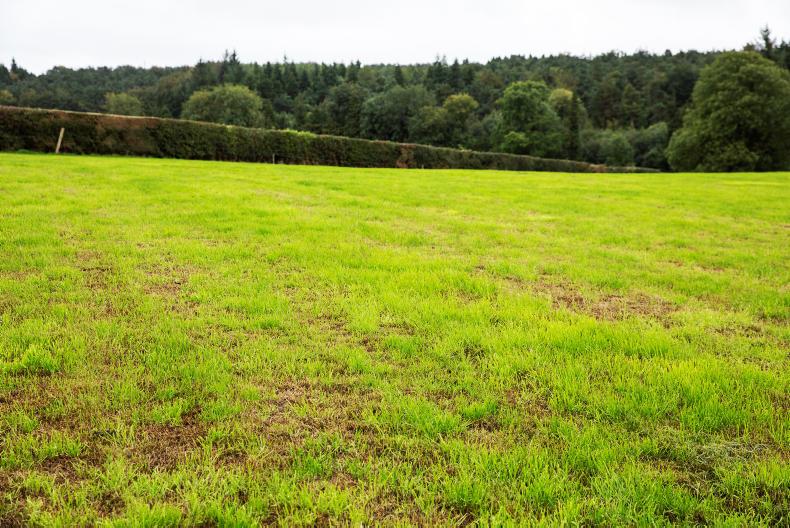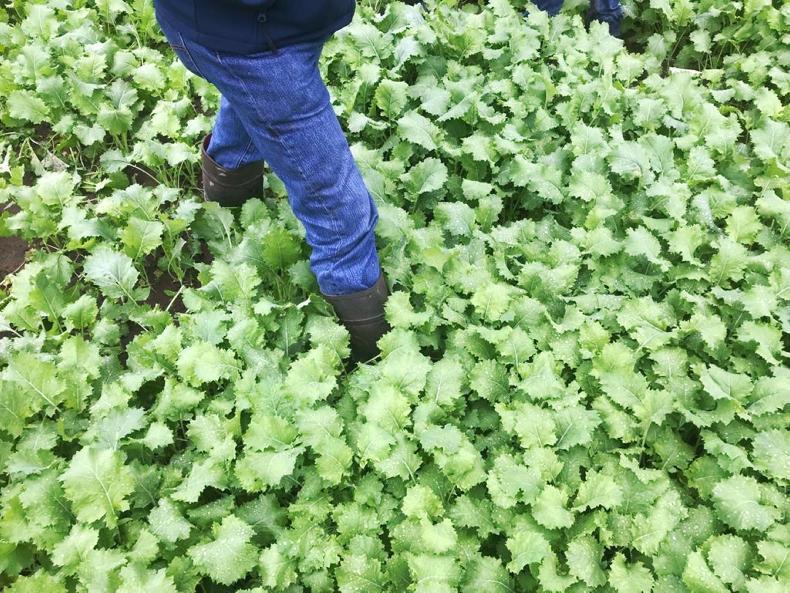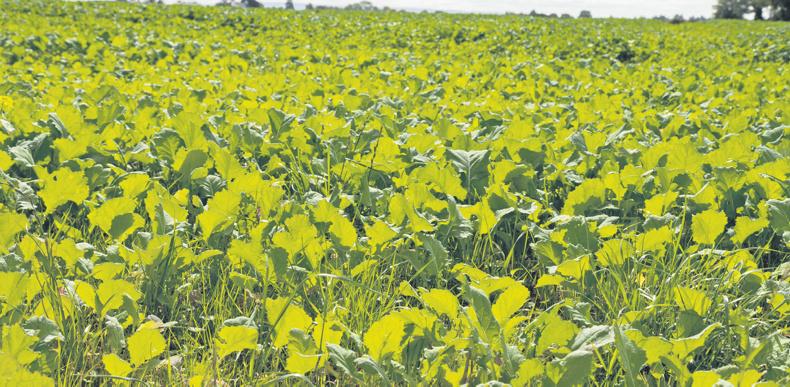Good growth rates are helping to improve the winter fodder situation on most farms.
A lot of farmers cut silage in the past week and are generally happy with the yields, with more bales per acre or loads of grass per acre than hoped for. It’ll all help towards bridging the gap between what the animals need and what’s available in the yard.
Average deficit
Looking at the national picture, according to Teagasc census results, the average deficit on farms is now at around 10%. Over the whole country, this is still a big deficit. If the deficit is still there by winter, it means that for every 10kg of feed an animal eats, the farmer only has 9kg of silage.
Of course 10% is just the average deficit on a small proportion of farms surveyed.
Some will be much worse than this and others will be better. We hear a lot of farmers talking about and wishing for a good back end or a good spring to help with the deficits on their farm. There’s no doubt that gaining a few weeks at either end will make a huge difference, but only if the grass is there to feed it.
For grass to grow, it needs fertile soil and good weather. We can’t influence the weather but we can influence soil fertility.
Fertiliser spreading deadlines
With fertiliser spreading deadlines coming at the end of September now is the time to be going with the last round. Slurry can be spread up to the end of October. A good few of the early sown Westerwolds and Italian ryegrass crops are getting harvested now.
If planning for another cut this autumn, they will need about 30 or 40kg/ha of nitrogen and probably the same in potash. We will return to Fodder Watch periodically over the coming weeks.
Rathcormac Co Cork: Third-cut silage

Jack Kearney cut his third cut last Wednesday and picked it up in ideal conditions on Thursday. Jack says it was cut dry. He cut half of it with his own 10ft mower and this was raked into 30ft swarths while the rest was cut by the contractor into 20ft swarths. They got 20 loads of silage from 37 acres of grass which works out at around 6t/acre of silage freshweight, which Jack is happy with.
He should have enough silage made now for the winter. He’s spreading slurry on the silage ground and in-calf heifers will get one more grazing off it this year.
Tullamore Farm, Co Offaly

Fodder crop on a livestock farm
The crop of Redstart and Interval on the Irish Farmers Journal farm at Tullamore is really flying it. Plenty of rain and lots of heat and sunshine over the past week have really helped drive-on growth rate. The crop is fully closed in and starting to motor.
We estimate that there is a cover of over 2,000kg/ha on it now and should reach 5t/ha DM by November. If it does this it will cost the same as paying €17/bale for silage, not including the cost of putting the field back to grass as it was going to be reseeded anyway.
Midlands: Buying third-cut silage

In Kilkenny, the farmer is watching the weather forecast with interest, waiting for the next dry day to get the silage in Mullingar cut. There is currently a cover of around 3,000kg/ha which is about six round bales per acre.
The bales are going to be wrapped in Westmeath and transported to Kilkenny on a curtain sided lorry for around €8 per bale for transport. Because of the distances being travelled, the bales will need to be dry so the grass will be tedded out after mowing.
Doneraile, Co Cork: Growing grass on a tillage farm

John Stokes cut some of his Westerwolds grass last week. The crop yielded a bit less than three bales per acre but John cut it to prevent seed heads emerging more so than for yield. He spread 30 units/acre of urea after cutting and hopes to take another cut in about five weeks’ time.
He expects that the light first cut will allow the grass to tiller and bulk up for the next cut. John says that when cutting the grass, light and fluffy soil wore the blades of the mower faster than normal. The bales have held their shape very well since they were made.
Athy, Co Kildare: Growing a fodder crop on a tillage farm

Michael O’Brien’s Redstart continues to bulk and has increased in height by nearly 10cm over the past seven days. He estimates that strip grazing of the crop by a local dairy farmer will commence in early November.
Michael says that in years where fodder demand is low, he wouldn’t have expected to get the required profit margin to make growing the crop worthwhile. However, there are other benefits this arrangement may bring to a tillage farmer, such as organic manures. In the future, he would create a stale seedbed before drilling and increase nitrogen rates to 75 units/ac.
Bunclody, Co Wexford: Spreading more fertiliser on a livestock farm

John Doyle reckons grass growth has slowed a little bit on his farm over the past week. A lot of rain has fallen, which is helping the fodder crops but some of the life is gone out of the grass.
His plan is to cut the silage next week. If the weather is agreeable he will leave it down for a day and ted it out then bale it up. John expects to get about seven round bales of silage per acre. If he gets this, spreading the extra nitrogen to grow more grass will have worked for him.
Good growth rates are helping to improve the winter fodder situation on most farms.
A lot of farmers cut silage in the past week and are generally happy with the yields, with more bales per acre or loads of grass per acre than hoped for. It’ll all help towards bridging the gap between what the animals need and what’s available in the yard.
Average deficit
Looking at the national picture, according to Teagasc census results, the average deficit on farms is now at around 10%. Over the whole country, this is still a big deficit. If the deficit is still there by winter, it means that for every 10kg of feed an animal eats, the farmer only has 9kg of silage.
Of course 10% is just the average deficit on a small proportion of farms surveyed.
Some will be much worse than this and others will be better. We hear a lot of farmers talking about and wishing for a good back end or a good spring to help with the deficits on their farm. There’s no doubt that gaining a few weeks at either end will make a huge difference, but only if the grass is there to feed it.
For grass to grow, it needs fertile soil and good weather. We can’t influence the weather but we can influence soil fertility.
Fertiliser spreading deadlines
With fertiliser spreading deadlines coming at the end of September now is the time to be going with the last round. Slurry can be spread up to the end of October. A good few of the early sown Westerwolds and Italian ryegrass crops are getting harvested now.
If planning for another cut this autumn, they will need about 30 or 40kg/ha of nitrogen and probably the same in potash. We will return to Fodder Watch periodically over the coming weeks.
Rathcormac Co Cork: Third-cut silage

Jack Kearney cut his third cut last Wednesday and picked it up in ideal conditions on Thursday. Jack says it was cut dry. He cut half of it with his own 10ft mower and this was raked into 30ft swarths while the rest was cut by the contractor into 20ft swarths. They got 20 loads of silage from 37 acres of grass which works out at around 6t/acre of silage freshweight, which Jack is happy with.
He should have enough silage made now for the winter. He’s spreading slurry on the silage ground and in-calf heifers will get one more grazing off it this year.
Tullamore Farm, Co Offaly

Fodder crop on a livestock farm
The crop of Redstart and Interval on the Irish Farmers Journal farm at Tullamore is really flying it. Plenty of rain and lots of heat and sunshine over the past week have really helped drive-on growth rate. The crop is fully closed in and starting to motor.
We estimate that there is a cover of over 2,000kg/ha on it now and should reach 5t/ha DM by November. If it does this it will cost the same as paying €17/bale for silage, not including the cost of putting the field back to grass as it was going to be reseeded anyway.
Midlands: Buying third-cut silage

In Kilkenny, the farmer is watching the weather forecast with interest, waiting for the next dry day to get the silage in Mullingar cut. There is currently a cover of around 3,000kg/ha which is about six round bales per acre.
The bales are going to be wrapped in Westmeath and transported to Kilkenny on a curtain sided lorry for around €8 per bale for transport. Because of the distances being travelled, the bales will need to be dry so the grass will be tedded out after mowing.
Doneraile, Co Cork: Growing grass on a tillage farm

John Stokes cut some of his Westerwolds grass last week. The crop yielded a bit less than three bales per acre but John cut it to prevent seed heads emerging more so than for yield. He spread 30 units/acre of urea after cutting and hopes to take another cut in about five weeks’ time.
He expects that the light first cut will allow the grass to tiller and bulk up for the next cut. John says that when cutting the grass, light and fluffy soil wore the blades of the mower faster than normal. The bales have held their shape very well since they were made.
Athy, Co Kildare: Growing a fodder crop on a tillage farm

Michael O’Brien’s Redstart continues to bulk and has increased in height by nearly 10cm over the past seven days. He estimates that strip grazing of the crop by a local dairy farmer will commence in early November.
Michael says that in years where fodder demand is low, he wouldn’t have expected to get the required profit margin to make growing the crop worthwhile. However, there are other benefits this arrangement may bring to a tillage farmer, such as organic manures. In the future, he would create a stale seedbed before drilling and increase nitrogen rates to 75 units/ac.
Bunclody, Co Wexford: Spreading more fertiliser on a livestock farm

John Doyle reckons grass growth has slowed a little bit on his farm over the past week. A lot of rain has fallen, which is helping the fodder crops but some of the life is gone out of the grass.
His plan is to cut the silage next week. If the weather is agreeable he will leave it down for a day and ted it out then bale it up. John expects to get about seven round bales of silage per acre. If he gets this, spreading the extra nitrogen to grow more grass will have worked for him.












 This is a subscriber-only article
This is a subscriber-only article












SHARING OPTIONS: